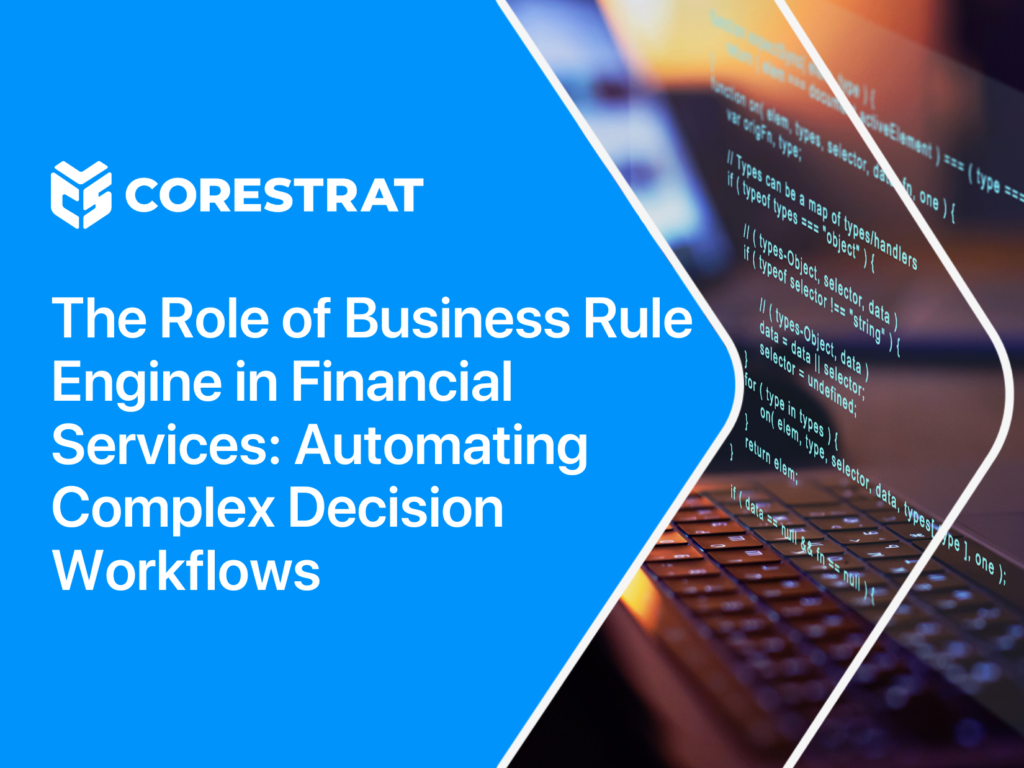In the fast-evolving world of financial services, where decisions must be made rapidly and accurately, automating complex workflows has become essential. Business Rule Engines (BREs) are a pivotal part of this shift, transforming how organisations streamline operations, reduce errors, and ensure compliance. By automating decision-making processes, BREs empower financial organisations to deliver consistent, accurate, and timely decisions, contributing to improved customer satisfaction and operational efficiency.
What is a Business Rule Engine?
A Business Rule Engine (BRE) is a system that automates the execution of business rules, allowing organisations to define, test, deploy, and maintain decision-making logic. This tool is essential in industries like financial services, where vast amounts of data, strict regulatory requirements, and high transaction volumes create complex workflows. Leveraging the power of big data, BREs enable businesses to make data-driven, consistent decisions with minimal human intervention, ensuring scalability and resilience.
Why are BREs Crucial in Financial Services?
The financial sector is characterised by its need for accuracy, compliance, and real-time decision-making. Traditional methods often require manual processes, which can be slow, inconsistent, and prone to errors. BREs are instrumental in overcoming these challenges by automating tasks such as credit scoring, fraud detection, and compliance checks.
Speed and Efficiency: In financial services, every second counts. BREs allow institutions to make decisions in milliseconds, significantly enhancing transaction speeds.
Consistency: Business rules ensure uniformity across decisions, reducing the risk of errors and improving compliance.
Cost-Effectiveness: By automating repetitive tasks, BREs reduce the need for manual intervention, lowering labour costs and freeing up resources for strategic initiatives.
Compliance and Risk Mitigation: BREs can be configured to adhere to regulatory requirements, ensuring that organisations stay compliant and minimise the risk of legal penalties.
How Business Rule Engines Work?
At its core, a BRE operates by applying predefined rules to data inputs. For example, a rule in a loan application process on the loan origination system could be: “If the applicant’s credit score is above 700, approve the loan application automatically.” These rules can be highly complex, involving multiple conditions, and are managed in a rule repository where they can be updated as policies change.
The workflow typically involves:
Defining Rules: Business analysts or decision-makers define rules based on company policies, regulations, and business goals.
Integrating Data Sources: The BRE integrates with various data sources, such as customer profiles, alternative data, and external credit bureaus.
Applying Rules: The engine applies the rules to incoming data, triggering specific actions or decisions.
Execution and Monitoring: The outcomes are recorded, allowing for audit trails and performance monitoring.
Key Applications of BREs in Financial Services
Credit Scoring and Loan Approvals
Banks and lending institutions use BREs to evaluate loan applications quickly and consistently. By automating credit scoring, they can reduce processing times from days to minutes.
For example, a lender can set up rules that automatically approve or reject applications based on factors like credit score, income, and employment history. This reduces the load on human underwriters, allowing them to focus on borderline cases that need in-depth analysis.
Fraud Detection and Prevention
Financial institutions lose billions annually due to fraud. Using BREs, companies can set up real-time fraud detection and credit risk management workflows, flagging suspicious transactions and applications based on a series of risk-based rules.
For instance, rules can trigger alerts when a transaction exceeds a certain amount, originates from a high-risk location, or involves an unusual pattern. If these criteria are met, the transaction is automatically flagged for further investigation or blocked temporarily.
Regulatory Compliance and Reporting
Regulatory compliance is one of the most complex areas for financial services due to the evolving nature of regulations. BREs can help automate the compliance process by ensuring that decisions comply with current regulations.
For example, Anti-Money Laundering (AML) and Know Your Customer (KYC) procedures can be automated using BREs. Rules can be defined to identify high-risk customers, flagging them for additional screening.
Advantages of Business Rule Engines
Improved Accuracy and Reduced Errors: Automated decision-making reduces human errors, ensuring that policies are applied consistently across transactions.
Enhanced Agility: Financial organisations can quickly adapt to new regulations or business conditions by updating rules in the BRE, avoiding lengthy re-coding processes.
Data-Driven Decision-Making: BREs leverage data to create highly specific and nuanced rules that reflect customer needs, financial risk, and market dynamics.
Reduced Operational Costs: By automating repetitive tasks, BREs allow staff to focus on value-added activities, reducing labour costs and boosting productivity.
Conclusion
As financial services continue to evolve, the demand for speed, accuracy, and compliance grows. Business Rule Engines address these needs by automating complex decision workflows, making it easier for financial institutions to operate efficiently and deliver consistent results. From credit scoring and fraud detection to regulatory compliance, BREs provide a robust solution for handling complex processes, reducing operational costs, and improving customer satisfaction.
Corestrat’s Business Rule Engine (BRE) empowers organisations to create, modify, and test rules for automated decision-making with ease. Its user-friendly, no-code interface enables users to build complex rules and strategies without requiring technical expertise, streamlining the process significantly. BRE can operate independently or integrate seamlessly with our other solutions, such as Digital Lending Automation—a powerful AI-driven lending automation platform—and ID.ai, our intelligent decision-making system.



